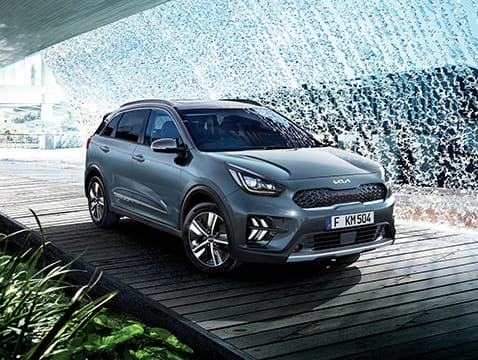The new WLTP l Kia UK

FOR A CLEARER PICTURE OF VEHICLE EMISSIONS AND CONSUMPTION
The testing measures for car pollutants, emissions and fuel consumption are changing. That’s because the old system, the so-called New European Driving Cycle (NEDC) introduced in the 1980s, has become outdated. It will gradually be replaced by the Worldwide Harmonised Light Vehicle Test Procedure (WLTP). Whereas the NEDC was based on theoretical driving, the new laboratory test is designed to give a more accurate picture of fuel consumption, pollutants and CO2 emissions in passenger cars. The WLTP was launched as a global test cycle across different world regions to make data more comparable worldwide. It is gradually being rolled out across the European Union and other regions worldwide. From September 2018, all new cars must be certified according to the WLTP standard.
What’s the difference between NEDC and WLTP?
The new WLTP test aims to provide more accurate comparable vehicle data that better reflects realistic driving conditions. For example, while the old NEDC standard only covered two driving scenarios (urban & extra-urban, to give a combined value) - the WLTP driving cycle is divided into four parts with different average speeds: low, medium, high, and extra high, to give a combined value of all scenarios. Each part contains a variety of driving phases, stops, acceleration and braking phases. For a certain car type, each powertrain configuration is tested with WLTP for the car’s lightest (most economical) and heaviest (least economical) version. It also takes into account the effects of optional equipment on weight and aerodynamics etc. As a result, both the test distance and the overall duration of the procedure have been extended. The combination of all these new measures should offer a real-world picture of a car’s performance on the road. Even so, it is important to bear in mind that the test is still based on lab data. WLTP cannot measure individual variables like personal driving style which can also impact fuel consumption and emissions.
NEDC and WLTP compared NEDC and WLTP compared
| TEST CONDITIONS | NEDC | WLTP |
|---|---|---|
| Test duration | 20 min. | 30 min. |
| Test distance | Approx. 11 kilometres | Approx. 23 kilometres |
| Time spent stationary | 25% | 13% |
| Test phases | Urban, extra-urban, (combined) | Low, Medium, High, Extra high, (Combined); (plus “City” for electric vehicles and vehicles with plug-in hybrid drivetrain) |
| Speed | Average: 34 km/h Maximum: 121 km/h | Average: 46.6 km/h Maximum: 131 km/h |
| Start temperature | 20-30°C - Cold engine start | 14°C – 23°C - Cold engine start |
| Special equipment options | Not taken into consideration. | CO2 values will now take into account the weight and effects on aerodynamics of optional equipment such as tyres, air conditioning etc. |
WLTP transition timeline
-
1
SINCE SEPTEMBER 2017
New models are tested according to WLTP. During this interim period, data is back-translated into NEDC values to allow for better comparison with older models. -
2
SEPTEMBER 2018
All cars sold in the EU as well as in Switzerland, Turkey, Norway, Liechtenstein, Israel and Ireland must be certified with WLTP. An exception will be made for end-of-series vehicles to allow for a limited number of unsold vehicles in stock that were approved under the old NEDC test to be sold for one more year.
-
3
JANUARY 2019
All car dealerships will show test values only according to WLTP on all their new models (European Commission recommendation, subject to a national government decision). -
4
DECEMBER 2020
All countries that adopt the EU legislation for vehicle registration will have to supply WLTP values for all vehicles.

WLTP benefits at a glance
- More realistic driving behaviour
- A greater range of driving situations (urban, suburban, main road, motorway)
- Longer test distances
- More realistic ambient temperatures
- Higher average and maximum speeds
- Higher average and maximum drive power
- More dynamic and representative accelerations and decelerations
- Shorter stops
- Optional equipment: CO2 values and fuel consumption are provided for individual vehicles as built
- Stricter car set-up and measurement conditions
- Allows best and worst-case values to reflect the options available for similar car models
For a greener future with WLTP
CLEARER PICTURE, BRIGHT OPPORTUNITY
FIND OUT MORE ABOUT KIA’S GREEN CAR RANGE:
Kia Guide to greener driving
-
EcoDynamics - Intelligent Thinking
Our fuel stretching EcoDynamics technology helps save up to 12% more fuel and reduce your carbon footprint - It cuts off the engine whenever the car is stationary, and gets you going again, simply by pressing the clutch.
-
Gearshift indicator
The gearshift indicator advises you when to change gear, thus saving fuel, reducing emissions and reducing wear and tear.
-
Less is more
Minimise the use of air-conditioning, demister etc. – just like everyday household items, these consume power which affects fuel consumption.
-
Smart stopping
Avoid engine idling. If you’re stationary for more than 40 seconds, turn the engine off to save fuel.
-
Tyres
Stay pumped up: Regularly check your tyres. Underinflated tyres waste fuel and affect handling, and increase wear.
-
Recycling your car
One of our goals is to dispose environmentally friendly cars in an equally environmentally friendly way. That’s why we use Design for Recycling (DfR) guidelines and offer an 'End-of-life' recycling scheme.


 Discover Kia’s pioneering 7 year warranty.
Discover Kia’s pioneering 7 year warranty.